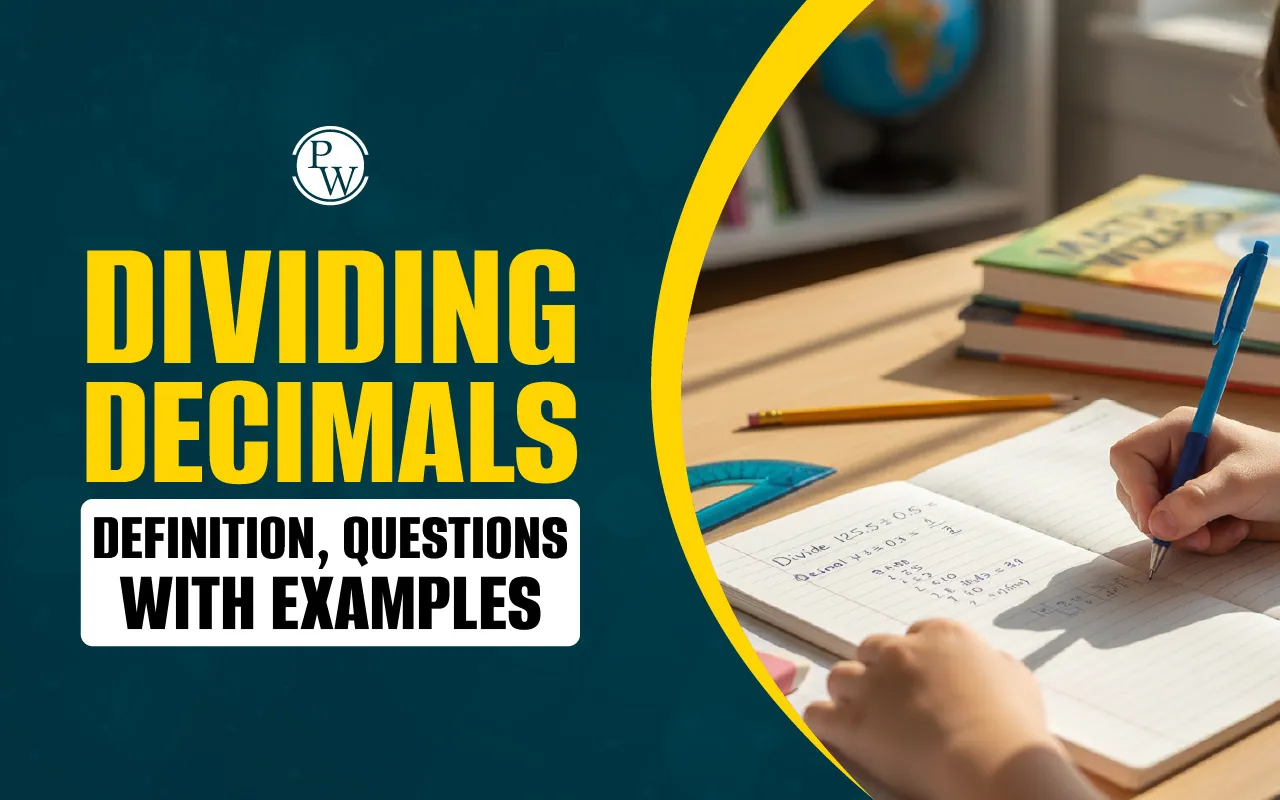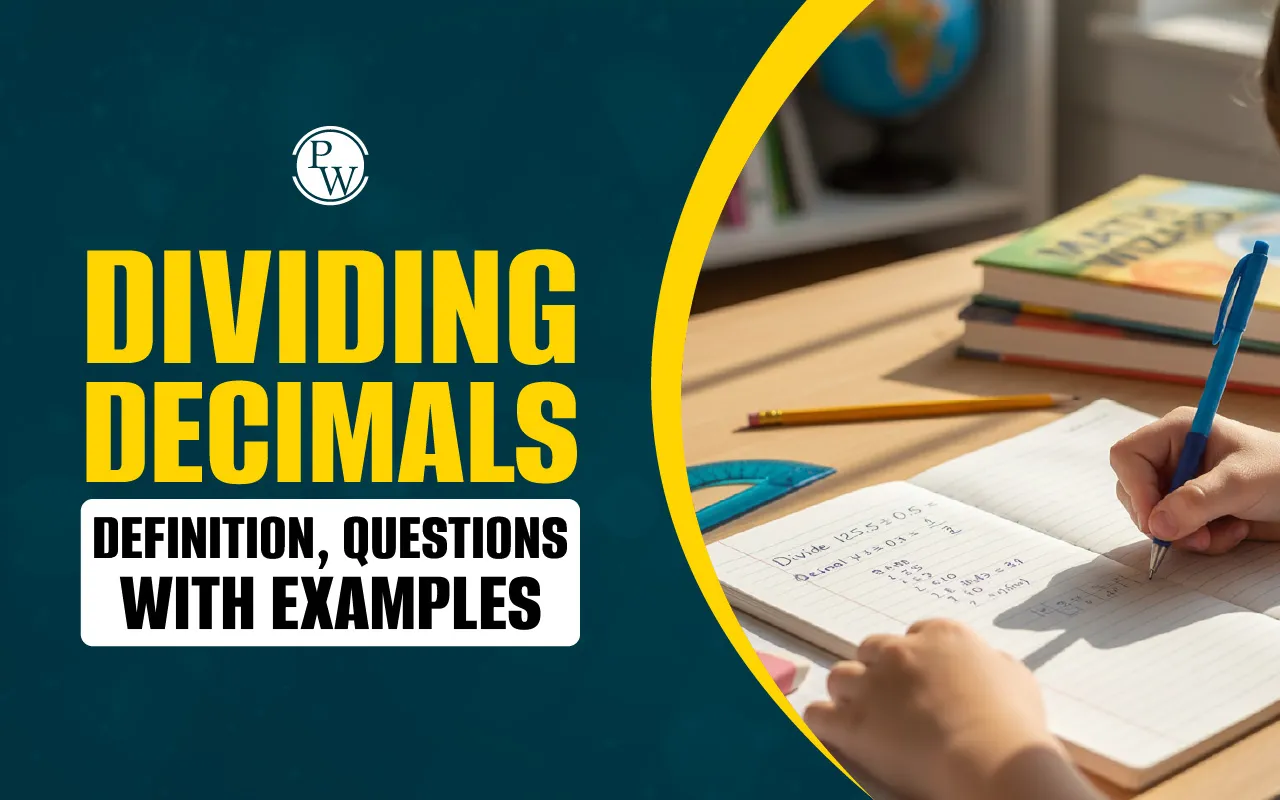

What Is the Division of Decimals?
Division of decimals means dividing a decimal number into several parts, each having the same value. It’s just like normal division, but in this case, one or both numbers (dividend and divisor) contain a decimal point.
For example: 6.9 ÷ 3 = 2.3
Here, 6.9 is a decimal number that is divided into 3 equal parts, and the value of each part is 2.3, which is a decimal number.
In division with decimals, the basic idea remains the same as in whole number division, but the placement of the decimal point in the result makes it slightly different from whole number division.
Types of Decimal Division
There are mainly two types of decimal divisions as follows:
-
Dividing a Decimal by a Whole Number
-
Dividing a Decimal by Another Decimal (Decimal by Decimal Division)
Both follow the same principle of division, but we handle the decimal points differently in each case. Let’s understand both types in detail.
Dividing Decimals by Whole Numbers
While dividing decimals by whole numbers, follow these steps:
-
Set up the division as you normally would.
-
Divide as if there were no decimal point.
-
Place the decimal point in the quotient the same as the position of the decimal point in the dividend (starting from the right).
Example: 7.5 ÷ 3
Consider 7.5 as 75 and divide by 3.
The quotient is 25.
Now, following the position of the decimal in the dividend (7.5), place the decimal before 5 in the quotient to get 2.5.
Therefore, 7.5 ÷ 3 = 2.5.
Decimal by Decimal Division
Students often need to divide a decimal number by another decimal number. The steps are as follows:
-
Move the decimal point in the divisor to make it a whole number.
-
Move the decimal point in the dividend the same number of places to the right.
-
Now perform the division operation as explained earlier.
Example: 5.6 ÷ 0.7
-
Step 1: The divisor is 0.7, so move the decimal point one place right to make it 7.
-
Step 2: Move the decimal point in the dividend (5.6) one place right to make it 56.
-
Step 3: Now divide 56 by 7 to get 8 as the quotient.
Therefore, 5.6 ÷ 0.7 = 8.
Read More: Composite Numbers
Long Division with Decimals
Sometimes, when dividing one whole number by another, long division is required to get decimal results.
Example: 17 ÷ 5
Step 1: Here, 5 x 3 = 15, so we get the quotient 3.
Step 2: The remainder is 17-15 = 2. We make it 20 by adding a decimal point in the quotient and putting a zero after 2.
Step 3: Divide 20 by 5 to get the quotient 4.
Therefore, the quotient becomes 3.4.
So, the answer is 17 ÷ 5 = 3.4.
Read More: Multiplying Decimals
Dividing with Decimals Examples
After understanding what decimal division is, students can practice with more sums to strengthen their concept of decimal division. Let’s look at a few more examples of dividing with decimals as given below:
Example 1:
2.5 ÷ 5 = ?
Solution: Divide as 25 ÷ 5 = 5 and place the decimal before the one's place in the dividend.
Answer: 2.5 ÷ 5 = 0.5
Example 2: 12.6 ÷ 0.9 = ?
Solution: Move the decimal in 0.9 one place to the right to make it 9.
Move the decimal in 12.8 one place to the right to make it 126.
Now, divide 126 by 9 to get the quotient 14.
Answer: 12.6 ÷ 0.9 = 14.
Example 3: 5.58 ÷ 0.3 = ?
Solution: Move the decimal in 0.3 one place to the right to make it 3.
Move the decimal in 5.58 one place to the right to make it 55.8.
Divide 55.8 ÷ 3 to get the quotient 18 and remainder 1.8.
Consider 1.8 as 18, and 18 ÷ 3 = 6.
In the quotient 186, place the decimal according to the last dividend, 1.8.
So, the final quotient obtained is 18.6.
Answer: 6.18 ÷ 0.3 = 18.6
Example 4: 9 ÷ 15 = ?
Solution: Here the dividend is smaller than the divisor.
Here, the quotient starts with a decimal point, and a zero is added in the dividend.
So, the dividend becomes 90.
We have 90 ÷ 15 = 6.
Therefore, the quotient becomes 0.6.
Answer: 9 ÷ 15 = 0.6
Read More: Numbers Up To 5 Digits
Common Mistakes to Avoid in Decimal Division
When working with decimals, there are chances of making small errors that lead to incorrect results. Here are a few things to watch out for during division with decimal numbers:
-
Forgetting to move the decimal point in both dividend and divisor during decimal-by-decimal division.
-
Misplacing the decimal point in the quotient.
-
Forgetting to put zero in the dividend while adding decimals in the quotient when the division isn’t exact.
Real-Life Uses of Dividing with Decimals
Understanding decimal by decimal division isn’t just an academic exercise; it’s a skill used in real life also, as explained below:
-
Shopping: Dividing total price by number of items to find cost per item.
-
Travel: Calculating distance, time, and fuel efficiency.
-
Finance: Finding unit rates, interest, or discounts.
Dividing with decimals might look tricky at first, but with a clear understanding of the rules, students can find it straightforward and logical. With more practice, your child becomes an expert in dividing decimals, which is a valuable math skill required for many practical purposes.
Also read: Perimeter of a Circle
Make Maths Fun and Fear-Free with CuriousJr!
Does your child get bored or anxious while solving math problems? Many kids find maths tricky and end up relying on fingers or calculators even for simple sums, which slows them down and affects their confidence.
CuriousJr’s Mental Maths Online Classes make learning enjoyable for students from Classes 1 to 8 through:
-
Live interactive sessions with fun examples and real-time teacher support.
-
Games, animations, and rewards that keep children engaged and motivated.
-
Dual Teacher Mentorship — one teacher for live classes, another for homework help and doubt-solving.
-
Daily practice and homework support to boost accuracy and speed.
-
Progress tracking and regular PTMs for parents to stay updated.
-
Complete school syllabus coverage with mental maths and Vedic Maths tricks like Skip Counting, Finger Maths, and Left-to-Right Addition.
Book a demo class with CuriousJr today!
